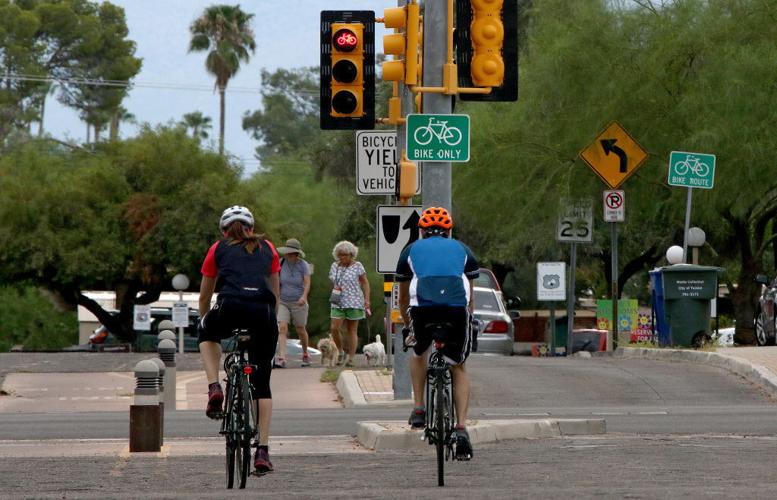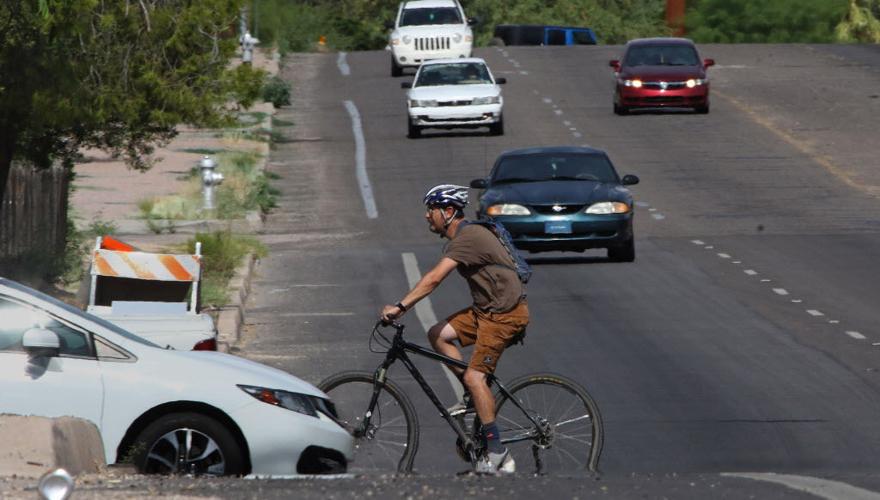For the spandexed among us, Tucson has a reputation as a cycling destination. That’s especially so as the mercury comes to rest in the mid-60s locally and cyclists elsewhere in the country turn to bike trainers and wait out the winter inside.
Nevertheless, and for at least the third four-year cycle running, Tucson and eastern Pima County have failed to make the cut for League of American Bicyclists’ top honor: being recognized as a Platinum Bicycle Friendly Community.
It again maintained its gold status, the organization’s second-highest honor (the group did recently add a diamond level, though no American city has achieved it. One city of Tucson official called it an “aspirational” designation).
In many ways, the Tucson area stacks up well compared to platinum cities like Portland, Oregon, and Davis, California. Its percentage of arterial and collector streets with bike lanes — 90 — bests the platinum average of 78 percent, its public outreach is considered “excellent” and there are active bike programs and groups that promote safety and advise local government, according to the region’s most recent “report card” from the league.
Where the region has consistently fallen short is the portion of commuters who bike to work and the frequency of bicycle-vehicle crashes, which this year exceeded the platinum average by a factor of five. Fatal crashes exceeded it by a factor of 12.
In the average platinum city, there were 90 crashes and 0.5 fatalities for every 10,000 bicycle commuters. In and around Tucson, those same figures were 458 and six, respectively.
What’s more, each figure more than doubled from what was reported in 2012, according to seven pages of feedback given to the Road Runner by the league. The figures are based on data submitted by applicants, in this case the Tucson-Pima County Bicycle Advisory Committee.
A program director with the league said the most recent application listed 1,528 bicycle crashes involving a motor vehicle between 2009 and 2013, and 20 fatalities in such crashes between 2011 and 2015 (More on these statistics, and why the picture may not be quite so grim, lower in the column).
The issue was again in the spotlight this spring when a driver plowed into a group of 10 mostly out-of-state cyclists in northwest Tucson, killing two and injuring three more. Just last week, another bicyclist was hit — on a road with a generous bike lane, no less — and was being treated for life-threatening injuries at last report.
Though the percentage of commuters riding to work has increased over the same period — from 1.7 percent to 3 percent — the area also still falls short of the 12 percent bar set by platinum cities.
Ann Chanecka, the city’s bicycle and pedestrian program coordinator, made the obvious but important point that the goal of her office and its county analog isn’t to get platinum status, but to “make Tucson more bike friendly” (though she acknowledged that achieving the distinction comes with branding advantages when trying to attract new businesses and residents to the Old Pueblo).
“Our focus has been to check off the things in the list,” she said of the recommendations made by the league, which includes creating “a bicycle boulevard grid” that provides “low-stress alternatives on low-speed and low-volume roads,” increasing bicycle education, completing the 131-mile paved trail system known as the Loop, implementing a bicycle share program and, of course, coming up with a plan to reduce crashes and fatalities.
Change is already afoot on several of those fronts. The city is set to release its Bicycle Boulevard Master Plan, which identifies 193 miles of residential streets and 64 corridors where safety features could be added. Work is already underway on 36 of those miles, Chanecka said. (As an example, think of University Boulevard, with its heavy signage, speed tables and specialized crossing beacons).
The Tucson City Council also recently approved a bike-sharing program, which features 30 stations mostly in and around the downtown area.
And the Loop, finished portions of which now encircle much of the city and stretch as far north as Catalina State Park, will more or less be a closed circuit by early 2017 when two loose ends near Fort Lowell Park are slated to be connected with a temporary route, according to Valerie Samoy of Pima County Natural Resources, Parks and Recreation.
All of these and other efforts, Chanecka said, make biking more accessible, safe and inviting to more people, and with more cyclists on the road, motorists’ awareness of them increases.
“We want to reduce our crashes and we want to reduce our fatal crashes to zero,” she said.
But is Tucson really that dangerous for cyclists? The metrics cited by the league certainly paint a relatively dark and worsening picture, and the steady stream of fatal and near-fatal crashes reinforce the perception. However, several people involved with the league’s Bicycle Friendly City program said there are reasons to be cautious about the figures for a city like Tucson.
That’s because the measures — crashes or fatalities per 10,000 commuters — only include the estimated number of commuters in the denominator and all crashes in the numerator, even if they involve a recreational cyclist not counted as a commuter.
“Cities that have a lot of recreational cycling, that vastly exceed the number of people using bikes for commuting purposes, it may be that the rate is going to look higher for those communities,” explained Steve Clark, program specialist with the league, echoing a similar point made by program director Bill Nesper.
Tucson, which Outside Magazine anointed America’s best cycling city in 2012 and whose streets in winter months are teeming with road riders, seems like a sensible place to read the data with a grain of salt.
But Kylie Walzak, with the bicycle advisory committee, said that shouldn’t put anyone at ease. Walzak’s group gets regular crash reports from local law enforcement, and her recollection of them is that “they are not involving recreational riders that often.”
She said no one has the data to settle the issue one way or another, but cautioned: “If we’re going to say these numbers are skewed and giving Tucson a bad name, then we need to know” for certain.
But even if there is a less-flawed metric for a place like Tucson, Chanecka said she and other local officials already have enough information to know more work is needed.
“Any death is too many,” she said.





